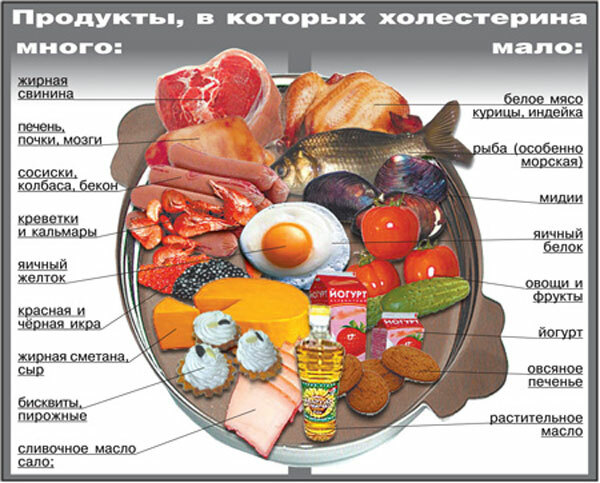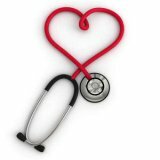Diet after myocardial infarction
After a severe illness, any person needs a full rehabilitation, which consists not only in the regular intake of medicines prescribed by the doctor, but also in changing the entire way of life. One of these ailments is myocardial infarction.
Rehabilitation of postinfarction patients is aimed at such basic goals as:
- constant adherence to the rules of rational dietary nutrition;
- fight against excess weight;
- almost constant monitoring of indicators of blood pressure, glucose and cholesterol in the blood;
- Stress prevention;
- sufficient motor activity.
One of the key roles in the recovery of the body after many diseases is the competent composition of the diet. In order to ensure a full recovery of the heart muscle after a heart attack, the patient must follow the diet No. 10 B, and then the diet No. 10 C. The daily menu should be full, varied and balanced.
Contents of
- 1 Basic principles of the diet after a heart attack
- 2 Three diets of diet №10 B
- 2.1 Ration I
- 2.2 Ration II
- 2.3 Ration III
- 3 How should the patient be fed after discharge from the hospital?
- 3.1 Diet No.10 Diet No.10
- 4 Unloading days for obesity
Basic principles of the diet after a heart attack
All patients who underwent myocardial infarction receive diet No. 10B approved by the and then diet No. 10 with , whose rations shouldPromote:
- to reduce the burden on the heart and blood vessels;
- restoration of vital activity of the myocardium;
- improvement in metabolic processes and circulation;
- weight stabilization, if you have extra pounds;
- normal operation of the digestive tract.
The basic principles of such a rational diet are as follows:
- decrease in the amount of consumed fats and carbohydrates to reduce the caloric content of the diet, and then gradually increase it;
- restriction of the use of free liquid and table salt( see "How much salt is needed for a man");
- the exclusion of foods that increase cholesterol levels( see Figure 1) and blood sugar;
- the exclusion of cold dishes and drinks below 15 ° C;
- the exclusion of products that cause bloating, irritate the digestive tract, kidney and liver - milk, offal( brain, liver, kidneys, lungs), legumes, cabbage, drinks with gas;
- exclusion of products that promote the excitation of the cardiovascular and nervous system - strong tea, coffee, cocoa, spices, alcoholic beverages( see "Refusal of coffee and tea - personal experience");
- exclusion of confectionery and baked goods;
- introduction to the diet of foods rich in vitamin P, ascorbic acid, potassium and magnesium - citrus, dogrose, sea-buckthorn, kiwi, black currant, dried apricots, prunes, dates, bananas, sea kale, oatmeal, buckwheat, etc.

Fig.1 - Cholesterol content in food.
Three diets of diet №10 B
After a heart attack, patients are assigned a diet number 10 B, which consists of three stages of prescription rations:
- diet I( the first 7 days after the infarction) - the food should be prepared in a gentle manner( by steaming or by boiling and then wiping) and eat 6-7 times a day in small portions;
- diet II( 2-3 weeks after a heart attack) - food should be cooked sparingly( by steaming or by boiling or quenching followed by grinding) and eat 6 times a day in small portions;
- diet III( from the 4th week) - food can be consumed in a crushed form or in a piece 5 times a day in small portions.
Ration I
Ration I must contain:
- proteins, fats and carbohydrates - 60 g: 30 g: 180 g;
- 1100-1300 kcal;
- liquid - up to 0,7-0, 8 liters;
- salt - is excluded completely.
The total weight of the I ration should not exceed 1700 g. Dishes must be cooked by steaming or by boiling and served warm and rubbed 6-7 times a day.
With ration I, the menu can include:
- the first dishes prepared with vegetable broth with mashed cereals, vegetables and egg flakes;
- wiped cottage cheese;
- steam fryadels, knels or cutlets from lean beef;
- boiled lean fish;
- an omelet made from proteins;
- mashed oats or buckwheat porridge on milk;
- semolina porridge;
- crackers( up to 50 g);
- puree, cooked from boiled carrots, beets or potatoes;
- low-fat kefir;
- jelly, fruit and mousse;
- not strong tea with lemon or with the addition of milk;
- infusion of prunes, raisins or dried apricots;
- juices: diluted with water, fruit, carrot or beetroot;
- rose hips;
- liquid jelly;
- alkaline mineral water( without gas).
All drinks should be warm or at room temperature and consumed in small volumes 8 times a day. Milk, refined vegetable and butter should be added only to dishes.
Ration II
Ration II should contain:
- proteins, fats and carbohydrates - 80 g: 50 g: 200 g;
- not more than 1600-1800 kcal;
- liquid - 0, 8 l;
- salt - 3 g.
The total weight of the ration should not be more than 2000 g. Dishes must be prepared by steaming, by boiling or quenching and served warm in crushed or wiped form 6 times a day.
With ration II, the menu can include:
- prepared on vegetable broth the first dishes with well-cooked vegetables, cereals or fruits;
- boiled or chopped low-fat meat and fish varieties or ground meat dishes;
- cottage cheese puddings with the addition of cereals, berries and fruits;
- casserole from manga and other cereals;
- low-fat and unsalted cheese;
- viscous and liquid not mashed porridge of buckwheat, mango and oats;
- dried wheat bread or crackers up to 150 g( or 200 g of wheat and 50 g of rye bread);
- puree from boiled potatoes, beets and carrots;
- baked apples;
- raw soft fruit and berries without coarse fiber;
- raw carrots, grating;
- dishes from cauliflower;
- low-fat cottage cheese and cheese( not salty);
- kefir;
- compotes and fruit drinks;
- fruit and milk jelly;
- jelly;
- mousses;
- not strong tea;
- sugar up to 50 g.
Milk, refined vegetable and creamy( up to 5 g) oil should be added only in sauces or dishes. To improve the taste in the dish can be added boiled and lightly toasted onions, tomato, lemon and fruit juices, sweet-sour sauces on a fruit, vegetable or milk basis.
Ration III
Ration III must contain:
- proteins, fats and carbohydrates - 90 g: 50-70 g: 300-320 g;
- 2100-2300 kcal;
- liquid - up to 1 liter;
- salt - 5 g.
The total weight of the ration should not be more than 2300 g. The food can be prepared by boiling, quenching or steaming and served with a chopped or chunk. Number of meals - 5 times a day. In the third diet, in addition to dishes of rations I and II, the following can be added:
- yesterday's wheat bread to 150 g( or biscuits, or 100 g of wheat and 50 g of rye bread);
- the first dishes cooked on low fat meat or vegetable broth;
- boiled jellied fish and meat;
- well soaked herring;
- ripe tomatoes;
- low-fat ham;
- braised beet with carrots;
- boiled pasta with the addition of cottage cheese;
- casseroles with manga with berries, apples or other fruits;
- cottage cheese puddings with croup, carrots, and fruits;
- butter up to 10 g( only in dishes).
How should the patient be fed after discharge from the hospital?
After the completion of the three diets of diet No. 10 B, the diet for the patient after the infarct is gradually expanded and transferred to a diet number 10 C. Patients with obesity 1-2 times a week are recommended to spend unloading days.
Diet № 10 With
The first variant of the diet №10 С is provided for obese people:
- proteins, fats and carbohydrates - 90 g: 70 g: 300 g;
- liquid - up to 1.2 liters;
- salt - 3-4 g;
- total weight of the ration - 2 kg;
- calorie content is 2100-2200 kcal.
The second variant of the diet No. 10 C is recommended for people with normal weight:
- proteins, fats and carbohydrates - 100 g: 80 g: 350 g;
- liquid - up to 1.2 liters;
- salt - up to 5-6 g;
- total weight of the ration - up to 2.5 kg;
- calorie content is 2400-2500 kcal.
Recommended dishes and products:
- yesterday or dried wheat bread from flour II grade, rye, cereal, peeled, unhealthy dry biscuits - up to 150 grams per day;
- vegetable, fruit, dairy, cereal first dishes, vegetarian borsch, soup and beetroot;
- fats - completely eliminated refractory fats, butter not more than 20-30 g per day, vegetable oils should be 1 / 2-1 / 3 of all fats;
- dishes from lean meat( pork, beef, chicken, turkey, rabbit), cooked by boiling, baking after boiling, served chopped or chunk;
- dishes from low-fat varieties of sea and river fish( salmon, pike perch, carp, cod, pike, navaga) in boiled, baked or lightly fried after pre-boiling;
- chicken eggs - 1 egg a day( soft-boiled or in the form of a protein omelet);
- dairy products - boiled milk, low-fat sour cream for making sauces or filling dishes, low-fat kefir, fermented baked milk, cottage cheese and unsalted, low-fat and non-cheesy cheeses;
- sauces - fruit sauce, sauces on vegetable broth, milk or sour cream;
- snacks - lean ham, vegetable salads, doctor's sausage, vinaigrette, canned vegetables;
- vegetables - in fresh, boiled or baked form;
- cereals - cereals, cooked on milk or water, raspberries, puddings or casseroles;
- pasta( preferably from hard wheat varieties);
- berries and fruits - ripe and sweet varieties, fresh, dried fruits;
- nuts are any, but with a calorie restriction;
- sugar - up to 50 g per day, part of which is better replaced with natural honey or jam( with excessive weight of sweets are sharply limited);
- drinks - fruit drinks, compotes, mousses, kissels, fruit juices with the addition of water( grape juice is excluded), broth of wild rose, weak tea or coffee.
The diet is significantly limited:
- products with a high cholesterol content: caviar, egg yolks, brains and other offal( see Figure 1);
- sweets.
Excluded from the diet:
- fresh bread;
- rich meat, mushroom, chicken and fish broth;
- cream;
- canned fish, poultry or meat;
- sausages;
- salted fish;
- fried and fatty dishes from meat, poultry and fish;
- yolks;
- baked pastry, cakes and cakes;
- sorrel;
- smoked products, spicy dishes and fatty and salty sauces;
- beans;
- radish, cucumber and radish;
- pickled, salted and pickled vegetables;
- products that cause bloating: raw milk, legumes, cabbage, fruits with coarse fiber, onion, garlic;
- mushrooms;
- spinach;
- horseradish;
- mustard, spices and condiments;
- cocoa, chocolate;
- natural coffee and strong tea;
- alcohol.
During the period of improving the condition of patients with reduced appetite, it is possible to include in the diet a small number of foods that contain fats and cholesterol:
- cream;
- beef sausages and sausages;
- eggs.
When making a daily menu, you should consider these recommendations:
- In the diet, it is better to introduce first or second courses from lean beef, fish, chicken, turkey, and more rarely - dishes from pork or lamb.
- With meat cut off the visible fat, and remove the skin from the chicken.
- For snacks, use fruits, berries or low-fat kefir.
- Food should be taken in 4 or 5 small meals, avoiding overeating.
- Dinner should be uninhabitable, and the dishes for it are not hot and not cold. It should take place 2-3 hours before bedtime.
Unloading days for obesity
To stabilize the normal weight against the background of compliance with the diet, it is necessary to spend unloading days:
- rice-compote day - 100 grams of rice porridge and 5 glasses of compote;
- 800 ml of water-diluted fruit juice and 500 g of oatmeal;
- apple day - 1.5-2 kg of baked or grated apples;
- watermelon day - 300 g watermelon 5 times a day.
Fulfillment of all the recommendations of the physician on rational nutrition after a recent myocardial infarction allows to accelerate the restoration of the heart muscle, accelerate recovery and facilitate the course of this dangerous disease. Subsequently, compliance with the diet can stabilize the course of coronary heart disease, the development of atherosclerosis and reduce the risk of developing repeated myocardial infarctions.
Cardiologist Petrova Yu.
Recommended for viewing:



